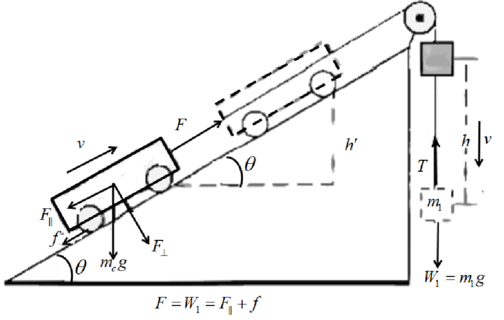
Concept explainers
The sum of the forces acting on the car and the sum of the forces acting on th descending mass.
Answer to Problem 1EP
The sum of the forces for the car is
Explanation of Solution
Draw a diagram to show the components of forces for a car moving in an inclided plane.

Write the expression for the sum of the force acting on the car.
Here,
Write the expression for parallel force acting on the car.
Here,
Write the expression for the sum of forces acting on the descending mass.
Here,
Conclusion:
Substitute
Thus, the sum of the forces for the car is
Want to see more full solutions like this?
Chapter 12 Solutions
Physics Laboratory Experiments
- Where is the center of mass of a semicircular wire of radius R that is centered on the origin, begins and ends on the x axis, and lies in the x, y plane?arrow_forwardTwo particles of masses m1 and m2 move uniformly in different circles of radii R1 and R1 about the origin in the x, y-plane. The coordinates of the two particles in meters are given as follows ( z=0 for both). Here t is in seconds: x1(t)=4cos(2t) y1(t)=4sin(2t) x2(t)=2cos(3t2) y2(t)=2sin(3t2) a. Find the radii of the circles of motion of both particles. b. Find the x- and y-coordinates of the center of mass. c. Decide if the center of mass moves in a circle by plotting its trajectory.arrow_forwardYou have been called to testify as an expert witness in a trial involving a head-on collision. Car A weighs 1515 lb and was traveling eastward. Car B weighs 1125 lb and was traveling westward at 43.0 mph. The cars locked bumpers and slid castward with their wheels locked for 18.5 ft before stopping. You have measured the coefficient of kinetic friction between the tires and the pavement to be 0.750. What speed (in miles per hour) was car A traveling just before the collision? (This problem uses English units because they would be used in a U.S. legal proceeding.) UF mpharrow_forward
- A nucleus that captures a stray neutron must bring the neutron to a stop within the diameter of the nucleus by means of the strong force. That force, which "glues" the nucleus together, is approximately zero outside the nucleus. Suppose that a stray neutron with an initial speed of 1.1 × 10' m/s is just barely captured by a nucleus with diameter d = 1.5 × 1014 m. Assuming that the strong force on the neutron is constant, find the magnitude of that force. The neutron's mass is 1.67 x 1027 kg. %3D Number Unitsarrow_forwardIn the amusement park ride known as Magic Mountain Superman, powerful magnets accelerate a car and its riders from rest to 45m/s (about 100mi/h) in a time of 7.0s. The combined mass of the car and riders is 5.5×103kg. Find the average net force exerted on the car and riders by the magnets.arrow_forwardA baseball catcher is catching a fastball that is thrown at 43 m/s (96 mi/h) by the pitcher. If the mass of the ball is 0.15 kg and if the catcher moves his mitt backward toward his body by 8.0 cm as the ball lands in the glove, what is the magnitude of the average force acting on the catcher's mitt? Estimate the time interval required for the catcher to move his hands.arrow_forward
- You have been called to testify as an expert witness in a trial involving a head-on collision. Car A weighs 1515 lb and was traveling eastward. Car B weighs 1125 Ilb and was traveling westward at 45.0 mph. The cars locked bumpers and slid eastward with their wheels locked for 22.5 ft before stopping. You have measured the coefficient of kinetic friction between the tires and the pavement to be 0.750. How fast (in miles per hour) was car A traveling just before the collision? (This problem uses English units because they would be used in a U.S. legal proceeding.) speed of car A: mpharrow_forwardA 2200 kg car is driving down a highway at a constant velocity when a deer jumps out onto the road 50.5 m ahead. The coefficient of friction between the car tires and the road is 0.29. Calculate the initial velocity of the car if it is able to stop just before hitting the deer. (You do not need to account for reaction time of the driver. Assuming the car is breaking the entire 50.5 m distance and that friction is the only force stopping the car.) v0 = m/sarrow_forwardTwo spheres A and B are placed in the arrangement shown below. If mA = 3m and mB = 8m, where on the dashed line should a third sphere C of mass 8m be placed so that the net force on it is zero? (b) If the distance between the two spheres A and B is 500 cm, find the location for the third sphere C so that the net force on it is zero. cm to the right of sphere B *answer for b*arrow_forward
- According to a simplified model of a mammalian heart, at each pulse approximately 20 g of blood is accelerated from 0.25 m/s to 0.35 m/s during a period of 0.10 s. What is the magnitude of the force exerted by the heart muscle?arrow_forwardA uniformly-dense equilateral triangle with weights hanging from each vertex is fixed at its center of mass as shown below: The triangle has a mass of 2kg and each side has a length of 0.50 meters, and it is held so that the vertex connected to F, is at an angle of 45° from the horizontal. All weights hang vertically downwards, where F,-25 N. F2-15 N and F3-10 N. What is the magnitude of the angular acceleration when the triangle is released and allowed to rotate, in rad/s? Justify your answer with your rationale and equations used. Irtangle MI Hint: Be careful with the angles you use for your calculation! Remember what the angle between vertexes of an equilateral triangle are. 63 梦 00 99arrow_forwardA nucleus that captures a stray neutron must bring the neutron to a stop within the diameter of the nucleus by means of the strong force. That force, which "glues" the nucleus together, is approximately zero outside the nucleus. Suppose that a stray neutron with an initial speed of 1.9 × 107 m/s is just barely captured by a nucleus with diameter d = 1.3 × 10-¹4 m. Assuming that the strong force on the neutron is constant, find the magnitude of that force. The neutron's mass is 1.67 × 10-27 kg. Number Units Narrow_forward
 University Physics Volume 1PhysicsISBN:9781938168277Author:William Moebs, Samuel J. Ling, Jeff SannyPublisher:OpenStax - Rice University
University Physics Volume 1PhysicsISBN:9781938168277Author:William Moebs, Samuel J. Ling, Jeff SannyPublisher:OpenStax - Rice University
